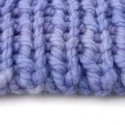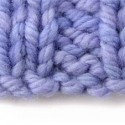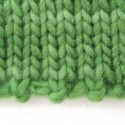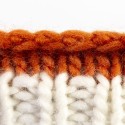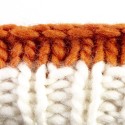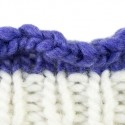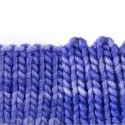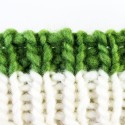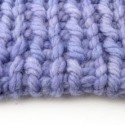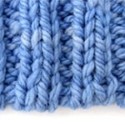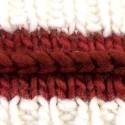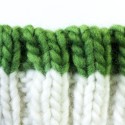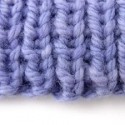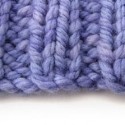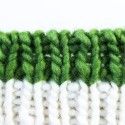Premium Video
Alternating Old Norwegian (Twisted German) Cast-On
Premium Video
To do the cast-on for ribbing as shown in the picture, do the knit and purl versions in whatever combination your ribbing is in (1×1, 2×3, etc.).
Channel Island Cast-OnPremium Video
Chinese Waitress Cast-On
Free Video
For a perfectly matching bind-off, use the Double-Chain Bind-Off.
Elastic Bind-OffPremium Video
Keep in mind that this bind-off will roll on Stockinette stitch. Just plan on that being a feature of the bind-off — maybe knit a couple extra rows before binding off to make up for the roll.
This bind-off would be nice on something like fingerless mitts, where the moderate stretch and decorative rolled look would work well.
EZ Sewn Bind-OffPremium Video
When I tried this bind-off I was surprised at how easy it was. It really only has two movements so, as an introduction to sewn bind-offs, this one is great.
This bind-off does have the tendency to roll forward, which is fine as long as it doesn’t take you by surprise. It is also quite slow (which is the norm for sewn bind-offs of any kind).
A warning for you about sewn bind-offs and delicate yarn: Any time that you’re using a delicate yarn, you’ll want to be careful when doing a sewn bind-off because you are pulling on the yarn more than you would for a knitted bind-off.
If you are using a delicate, one-ply yarn like Noro or Malabrigo Worsted, it could break.
I don’t think that will happen in this case, because you’re not putting a lot of stress on the yarn in this bind-off, but it’s important to know.
Also be careful because, like all sewn bind-offs, this bind-off is difficult and time-consuming to undo. Basically you have to take your tapestry needle and go back the way you came, slowly retracing your steps and putting each stitch back on the needle.
Therefore, you may want to try this bind-off on a small swatch before you do it on a larger project, just to make sure you understand it before using it on hundreds of stitches.
Frilled Decrease Bind-OffPremium Video
This bind-off is similar to the Frilled Standard Bind-Off only it’s noticeably more frilly. It gets its name from the Decrease Bind-Off, to which an extra movement (which you might recognize from the Suspended Variation Bind-Off) is added.
To get the full effect on this and any frilled or ruffled bind-off, you’ll need to block this it: get it wet, squeeze the water out, and shape the edge with your fingers to make it into a frill.
Hemmed Edge Bind-Off – Purl or PicotPremium Video


This is a perfect bind-off for toe-up socks where you don’t want to do ribbing, because it’s stretchy and sturdy and the edge doesn’t roll.
I really recommend that you try this technique. It’s a beautiful bind-off and you’re going to be very proud of yourself once you finish it.
I-Cord Bind-OffPremium Video
It does sort of help to know how to make an I-cord, but you don’t really need to because I explain it all to you in the tutorial below.
Options: You can work this bind-off in a contrasting color. In order to do that, just work the last row before the bind-off (the WS row) in the contrasting color and then do the bind-off in the contrasting color.
You can also make the I-cord as thick or thin as you want, and I include instructions below on how to do so.
One reason to make a thinner I-cord is to create a matching bind-off for the popular Chinese Waitress Cast-On. A 1-stitch I-cord bind-off is not a perfect match but it does match a lot of the characteristics.
A 3-stitch I-cord is shown in this tutorial.
Icelandic Bind-OffFree Video
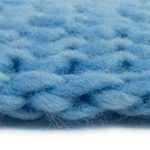
This is my #1 recommended bind-off for binding off on garter stitch.
See how this bind-off compares to other good bind-offs for Garter stitch in Bind-Offs for Garter Stitch.
Be warned that this edge will roll if you do it on Stockinette stitch, so just make sure that that’s a feature that you want on your knitting.
Invisible Ribbed Bind-Off for 1×1 RibPremium Video
If you already know Kitchener Stitch, you’ll have a good foundation for this bind-off. However, it’s not a prerequisite.
Speaking of which, there are no prerequisites in this course – you can jump in wherever you want as long as you can knit and purl and you have an adventurous attitude.
The main thing to keep in mind as you learn the Invisible Ribbed Bind-Off is to take a deep breath, go slow, and KNOW you can do it.
Don’t expect yourself to memorize all the moves right away. It will help you to think of the bind-off as consisting of only 2 basic movements.
Make a swatch of at least 30 stitches so that you can really practice this. As you go, repeat the mantra “knit-off purl, purl-off knit,” “knit-off purl, purl-off knit” in your head as you do these movements, and you will never forget what to do.
Warning: If you’re using a delicate yarn like any single-ply yarn like Noro (which has a tendency to break anyway) or even Malabrigo Worsted, be careful on this bind-off. Don’t work very many stitches before you pull your yarn tight or it might break. Just do one move and then tighten your yarn, and you’ll avoid that problem.
This bind-off, like all sewn bind-offs, is painstaking to undo. If you need to undo this bind-off, just backtrack slowly and check to make sure it looks right as you go.
This is a pretty advanced bind-off so pat yourself on the back if you give it a try — whether or not you succeed at first. Well done!
Download an illustrated guide to the Invisible Ribbed Bind-Off here.
Make sure you watch your tension on this bind-off. Give the bound-off edge a tug every so often as you go to get a feel for how you are doing.
The nice thing about this bind-off is that you can “make up for” bad tension – if you do a few stitches too tight, you can do the next few a little loose, and things will sort of even out.
Italian Tubular (Invisible Ribbed) Cast-On for 1×1 RibPremium Video
Matching bind-off: Invisible Ribbed Bind-Off for 1×1 Rib.
Italian Tubular Cast-On for 2×2 RibPremium Video
This cast-on is special in that it has a matching bind-off: the Kitchener Double-Rib Bind-Off.
Japanese Bind-OffPremium Video
While working with three needles can be challenging, the Japanese Bind-Off is the easiest of the three-needle bind-offs and a good place for you to start.
Jeny’s Surprisingly Stretchy Bind-Off (JSSBO) for 2×2 RibPremium Video
The first bind-off I adapted for 2×2 rib was Jeny’s Surprisingly Stretchy Bind-off. As predicted for this versatile bind-off, it worked great.
Because it is derived from Jeny’s Surprisingly Stretchy Bind-Off for 1×1 Rib, if you’ve already learned that bind-off, this one should be really easy. You just repeat each move for either the knit stitch or the purl stitch one more time in order to do two knit stitches and two purl stitches.
This means that, by extrapolation, you can also do this bind-off for 1×3 rib, or 3×1 rib, or any combination of knit-and-purl ribbing.
Based on: Jeny’s Surprisingly Stretchy Bind-Off for 1×1 Rib.
Jeny’s Surprisingly-Stretchy Bind-Off (JSSBO) for 1×1 RibFree Video
Lots of patterns suggest that you use this bind-off, and I agree. I would consider this bind-off “required reading” for intermediate-level knitters.
JSSBO would work well for the ribbing at the bottom of a top-down sweater or at the brim of a top-down hat — anywhere you want the bind-off to not look stretched-out.
This bind-off is also a great choice for binding off lace projects.
This bind-off was invented by Jeny Staiman and published in Knitty in Fall 2009.
Kitchener Double-Rib Bind-OffPremium Video
The trick to this bind off (and it’s only a little scary) is to take the stitches off the needle and slide them onto two needles – one needle into the knits (which will naturally come forward) and one needle into the purls (which naturally recede).
Then all that remains is to bind off the stitches with Kitchener Stitch (which I show you in this tutorial as well as in its own place in this course).
Take it from me that this technique is about 100 times easier than the Invisible Ribbed Bind-Off for 2×2 Rib.
Latvian Bind-OffPremium Video
This bind-off looks similar to the Long-Tail Cast-On when viewed from the right side, and the Old Norwegian Cast-On when viewed from the wrong side.
I chose to include this bind-off because it is really pretty as well as being very stretchy.
Most of the ribbed bind-offs are kind of utilitarian so I wanted to give you a more decorative option.
In fact, this bind-off is also gorgeous on Garter stitch.
The Latvian bind-off is the least sturdy of all the stretchy bind-offs. Don’t expect this bind-off to hold up the cuff of your sock — if you decide to use it to bind-off toe-up socks, make sure you do enough rows of ribbing so that the ribbing does that job.
Old Norwegian (Twisted German) Cast-OnFree Video
Premium Video
Tillybuddy’s Cast-On
Premium Video
Tubular Bind-Off for 1×1 Rib
Premium Video
The premise of this technique is that you do a couple set-up rows, then separate the stitches onto 2 needles (easier than it sounds), and then bind them off invisibly with Kitchener Stitch.
If you don’t know Kitchener Stitch, it’s worth learning so that you can have this bind-off in your arsenal.
As far as speed goes, this is a sewn bind-off, which means that it is slow (pretty much all sewn bind-offs are slow). But I think that if you’re fast at Kitchener stitch you’ll find that this bind-off can be fast as well.
Another drawback is that this bind-off, like all sewn bind-offs, is painstaking to undo. If you need to undo the Kitchener-stitch portion of this bind-off, just backtrack slowly and check to make sure it looks right as you go.
A potential drawback to the Tubular Bind-Off is that if you are binding off a lot of stitches (probably on a circular needle), it may be cumbersome to take them all off and put them onto two separate needles before binding off.
If you decide to do it anyway but you don’t have two of the same-sized circular needles handy, don’t worry about that — you can slip the stitches onto smaller needles or even needles of two different sizes.
Options For This Bind-Off
You can do either a 2-row or a 4-row setup before you work the Kitchener stitch portion of this bind-off.
The 4-row setup will give a fuller, rounder look to the edge (and also match a Tubular Cast-On done with 4 setup rows).]
The bind-off pictured above used a 2-row setup (which seems sufficient to me).
If you are binding off in the round, you will need to work the setup rows in the round.
On the first round, slip the purl sts wyif, and on the second round, slip the knit sts wyib.
Warning: It’s important that you don’t do the Kitchener stitch part of this bind-off too tight. That would really interfere with the stretchiness of this bind-off.
ZigZag (Ancient Greek) Bind-OffPremium Video
The interesting thing about this bind-off is that it has an ancient origin. In her book, Cast On, Bind Off, Cap Sease writes that this bind-off was discovered on the heel of an ancient Greek sock! That makes this a very old bind-off indeed.
